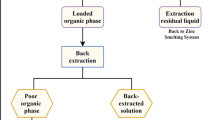Abstract
Present zinc refining in sulfate circuits creates considerable amounts of residuals that are often disposed in densely populated sites around the world, creating disposal and environmental liability issues for producers. A combination of chloride and sulfate circuits offers attractive possibilities for residue-free zinc refining, resulting in lower capital and operating costs for producers.
Similar content being viewed by others
References
E. Molleman, A. van Sandwijk, and G. Van Weert, “Acid Dissolution of Iron-Bearing Zinc Concentrates: A First Step Towards Residue-Free Zinc Refining,” Minerals & Metallurgical Processing, 15 (3) (1998), pp. 38–42.
P.G. Thornhill, E. Wigstol, and G. Van Weert, “The Falconbridge Matte Leach Process,” J. Metals, 23 (7) (1971), pp. 13–18.
E.O. Stensholt, H. Zachariassen, and J.H. Lund, “The Falconbridge Chlorine Leach Process,” Extraction Metallurgy ’85 (London: IMM, 1985), pp. 377–298.
D.M. Muir et al., “Recent Development in Chloride Hydrometallurgy,” Extr. Metallurgy Symp. Proc. (Melbourne, Australia: AusIMM, 1984), pp. 153–161.
A. van Sandwijk and M. Schipper-Zablotskaja, “Zinc Oxide Precipitation from Solutions Containing High Concentrations of Chloride Ions,” Proc. Milton E. Wadsworth Int. Symp. Hydrometallurgy, ed. J.B. Hiskey and G.W. Warren (Littleton, CO: SME, 1993), pp. 947–955.
G. Van Weert et al., “Treatment of Iron Making Blast Furnace Dust by Hydrometallurgy,” Proc. Milton E. Wadsworth Int. Symp. Hydrometallurgy, ed. J.B. Hiskey and G.W. Warren (Littleton, CO: SME, 1993), pp. 931–946.
L.J.F. Harris, “Introduction to Spray Roasting Process for Hydrochloric Acid Regeneration and Its Applications to Mineral Processing,” Hydromet ’94 (London: IMM, 1994), pp. 923–937.
Hans Jedlicka, Production of Magnesia (+99% MgO) by the Ruthner HCl Route (Vienna, Austria: Andritz-Ruthner).
J.A. Epstein, “Utilisation of the Dead Sea Minerals (A Review),” Hydrometallurgy, 2 (1976), pp. 1–10.
A.L. Kohl and R. Nielson, Gas Purification, 5th ed. (Houston, TX: Gulf Publishing Co., 1997), pp. 1305–1311.
J.E. Houghton and R.W. Bucklin, “Non-Regenerable H2S Scavenger Update” (Paper presented at the 44th Annual Lawrence Reid Gas Conditioning Conference, University of Oklahoma, Norman, OK, February 27–March 2, 1994).
E.M.L. Peek, “Removal of Zinc and Lead from Iron and Steel Wastes via Chloride Pyrohydrolysis,” Zinc and Lead ’95 (Sendai, Japan: MMIT and CIM, 1995), pp. 457–471.
E.M.L. Peek and G. Van Weert, “Iron/Zinc Separation by Fluidised Bed Pyrohydrolysis: What’s Thermodynamically Possible?” Ertzmetall, 48 (12) 1995), pp. 843–854.
Author information
Authors and Affiliations
Additional information
For more information, contact G. Van Weert, OreTome Limited, 16668 Humberstation Road, R.R. No. 3, Caledon East, Ontario, Canada L0N 1E0; (905) 880-3142; fax (905) 880-3748.
Rights and permissions
About this article
Cite this article
Van Weert, G., van Sandwijk, T. Routes to residue-free zinc refining. JOM 51, 26–28 (1999). https://doi.org/10.1007/s11837-999-0167-7
Issue Date:
DOI: https://doi.org/10.1007/s11837-999-0167-7




